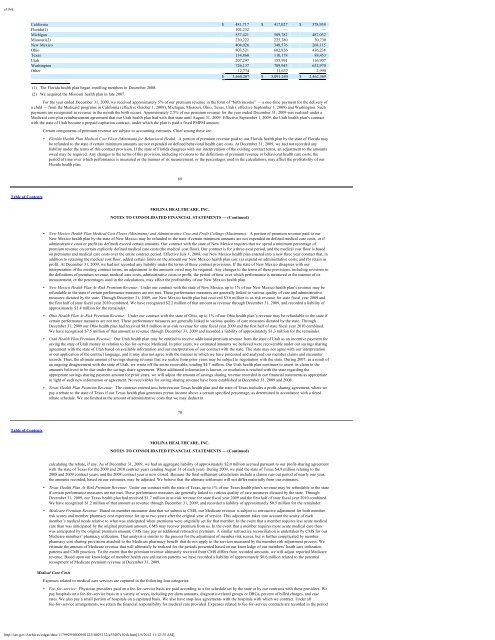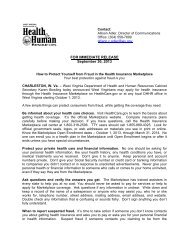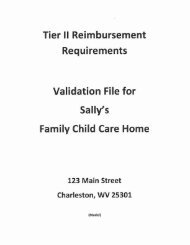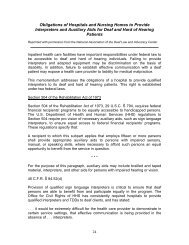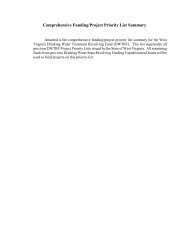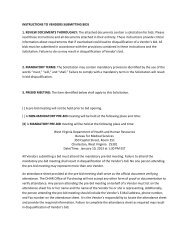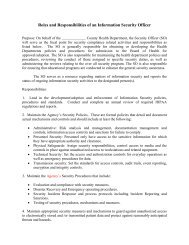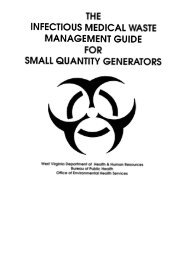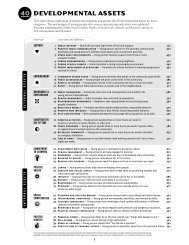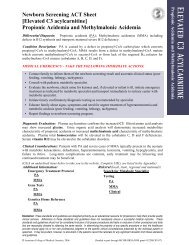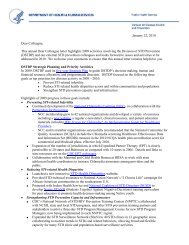Molina Medicaid Solutions - DHHR
Molina Medicaid Solutions - DHHR
Molina Medicaid Solutions - DHHR
You also want an ePaper? Increase the reach of your titles
YUMPU automatically turns print PDFs into web optimized ePapers that Google loves.
e10vkCalifornia $ 481,717 $ 417,027 $ 378,934Florida(1) 102,232 — —Michigan 557,421 509,782 487,032Missouri(2) 230,222 225,280 30,730New Mexico 404,026 348,576 268,115Ohio 803,521 602,826 436,238Texas 134,860 110,178 88,453Utah 207,297 155,991 116,907Washington 726,137 709,943 652,970Other 12,774 11,637 2,990$ 3,660,207 $ 3,091,240 $ 2,462,369(1) The Florida health plan began enrolling members in December 2008.(2) We acquired the Missouri health plan in late 2007.For the year ended December 31, 2009, we received approximately 5% of our premium revenue in the form of “birth income” — a one-time payment for the delivery ofa child — from the <strong>Medicaid</strong> programs in California (effective October 1, 2009), Michigan, Missouri, Ohio, Texas, Utah ( effective September 1, 2009) and Washington. Suchpayments are recognized as revenue in the month the birth occurs. Approximately 2.5% of our premium revenue for the year ended December 31, 2009 was realized under a<strong>Medicaid</strong> cost-plus reimbursement agreement that our Utah health plan had with that state until August 31, 2009. Effective September 1, 2009, the Utah health plan’s contractwith the state of Utah became a prepaid capitation contract, under which the plan is paid a fixed PMPM amount.Certain components of premium revenue are subject to accounting estimates. Chief among these are:• Florida Health Plan Medical Cost Floor (Minimum) for Behavioral Health. A portion of premium revenue paid to our Florida health plan by the state of Florida maybe refunded to the state if certain minimum amounts are not expended on defined behavioral health care costs. At December 31, 2009, we had not recorded anyliability under the terms of this contract provision. If the state of Florida disagrees with our interpretation of the existing contract terms, an adjustment to the amountsowed may be required. Any changes to the terms of this provision, including revisions to the definitions of premium revenue or behavioral health care costs, theperiod of time over which performance is measured or the manner of its measurement, or the percentages used in the calculations, may affect the profitability of ourFlorida health plan.69Table of ContentsMOLINA HEALTHCARE, INC.NOTES TO CONSOLIDATED FINANCIAL STATEMENTS — (Continued)• New Mexico Health Plan Medical Cost Floors (Minimums) and Administrative Cost and Profit Ceilings (Maximums): A portion of premium revenue paid to ourNew Mexico health plan by the state of New Mexico may be refunded to the state if certain minimum amounts are not expended on defined medical care costs, or ifadministrative costs or profit (as defined) exceed certain amounts. Our contract with the state of New Mexico requires that we spend a minimum percentage ofpremium revenue on certain explicitly defined medical care costs (the medical cost floor). Our contract is for a three-year period, and the medical cost floor is basedon premiums and medical care costs over the entire contract period. Effective July 1, 2008, our New Mexico health plan entered into a new three year contract that, inaddition to retaining the medical cost floor, added certain limits on the amount our New Mexico health plan can: (a) expend on administrative costs; and (b) retain asprofit. At December 31, 2009, we had not recorded any liability under the terms of these contract provisions. If the state of New Mexico disagrees with ourinterpretation of the existing contract terms, an adjustment to the amounts owed may be required. Any changes to the terms of these provisions, including revisions tothe definitions of premium revenue, medical care costs, administrative costs or profit, the period of time over which performance is measured or the manner of itsmeasurement, or the percentages used in the calculations, may affect the profitability of our New Mexico health plan.• New Mexico Health Plan At-Risk Premium Revenue: Under our contract with the state of New Mexico, up to 1% of our New Mexico health plan’s revenue may berefundable to the state if certain performance measures are not met. These performance measures are generally linked to various quality of care and administrativemeasures dictated by the state. Through December 31, 2009, our New Mexico health plan had received $3.6 million in at-risk revenue for state fiscal year 2009 andthe first half of state fiscal year 2010 combined. We have recognized $2.2 million of that amount as revenue through December 31, 2009, and recorded a liability ofapproximately $1.4 million for the remainder.• Ohio Health Plan At-Risk Premium Revenue: Under our contract with the state of Ohio, up to 1% of our Ohio health plan’s revenue may be refundable to the state ifcertain performance measures are not met. These performance measures are generally linked to various quality of care measures dictated by the state. ThroughDecember 31, 2009 our Ohio health plan had received $8.8 million in at-risk revenue for state fiscal year 2009 and the first half of state fiscal year 2010 combined.We have recognized $7.5 million of that amount as revenue through December 31, 2009 and recorded a liability of approximately $1.3 million for the remainder.• Utah Health Plan Premium Revenue: Our Utah health plan may be entitled to receive additional premium revenue from the state of Utah as an incentive payment forsaving the state of Utah money in relation to fee-for-service <strong>Medicaid</strong>. In prior years, we estimated amounts we believed were recoverable under our savings sharingagreement with the state of Utah based on available information and our interpretation of our contract with the state. The state may not agree with our interpretationor our application of the contract language, and it may also not agree with the manner in which we have processed and analyzed our member claims and encounterrecords. Thus, the ultimate amount of savings sharing revenue that we realize from prior years may be subject to negotiation with the state. During 2007, as a result ofan ongoing disagreement with the state of Utah, we wrote off the entire receivable, totaling $4.7 million. Our Utah health plan continues to assert its claim to theamounts believed to be due under the savings share agreement. When additional information is known, or resolution is reached with the state regarding theappropriate savings sharing payment amount for prior years, we will adjust the amount of savings sharing revenue recorded in our financial statements as appropriatein light of such new information or agreement. No receivables for saving sharing revenue have been established at December 31, 2009 and 2008.• Texas Health Plan Premium Revenue: The contract entered into between our Texas health plan and the state of Texas includes a profit-sharing agreement, where wepay a rebate to the state of Texas if our Texas health plan generates pretax income above a certain specified percentage, as determined in accordance with a tieredrebate schedule. We are limited in the amount of administrative costs that we may deduct in70Table of ContentsMOLINA HEALTHCARE, INC.NOTES TO CONSOLIDATED FINANCIAL STATEMENTS — (Continued)calculating the rebate, if any. As of December 31, 2009, we had an aggregate liability of approximately $2.0 million accrued pursuant to our profit-sharing agreementwith the state of Texas for the 2009 and 2010 contract years (ending August 31 of each year). During 2009, we paid the state of Texas $4.9 million relating to the2008 and 2009 contract years, and the 2008 contract year is now closed. Because the final settlement calculations include a claims run-out period of nearly one year,the amounts recorded, based on our estimates, may be adjusted. We believe that the ultimate settlement will not differ materially from our estimates.• Texas Health Plan At-Risk Premium Revenue: Under our contract with the state of Texas, up to 1% of our Texas health plan’s revenue may be refundable to the stateif certain performance measures are not met. These performance measures are generally linked to various quality of care measures dictated by the state. ThroughDecember 31, 2009, our Texas health plan had received $1.7 million in at-risk revenue for state fiscal year 2009 and the first half of state fiscal year 2010 combined.We have recognized $1.2 million of that amount as revenue through December 31, 2009, and recorded a liability of approximately $0.5 million for the remainder.• Medicare Premium Revenue: Based on member encounter data that we submit to CMS, our Medicare revenue is subject to retroactive adjustment for both memberrisk scores and member pharmacy cost experience for up to two years after the original year of service. This adjustment takes into account the acuity of eachmember’s medical needs relative to what was anticipated when premiums were originally set for that member. In the event that a member requires less acute medicalcare than was anticipated by the original premium amount, CMS may recover premium from us. In the event that a member requires more acute medical care thanwas anticipated by the original premium amount, CMS may pay us additional retroactive premium. A similar retroactive reconciliation is undertaken by CMS for ourMedicare members’ pharmacy utilization. That analysis is similar to the process for the adjustment of member risk scores, but is further complicated by memberpharmacy cost sharing provisions attached to the Medicare pharmacy benefit that do not apply to the services measured by the member risk adjustment process. Weestimate the amount of Medicare revenue that will ultimately be realized for the periods presented based on our knowledge of our members’ heath care utilizationpatterns and CMS practices. To the extent that the premium revenue ultimately received from CMS differs from recorded amounts, we will adjust reported Medicarerevenue. Based upon our knowledge of member health care utilization patterns we have recorded a liability of approximately $0.6 million related to the potentialrecoupment of Medicare premium revenue at December 31, 2009.Medical Care CostsExpenses related to medical care services are captured in the following four categories:• Fee-for-service: Physician providers paid on a fee-for-service basis are paid according to a fee schedule set by the state or by our contracts with these providers. Wepay hospitals on a fee-for-service basis in a variety of ways, including per diem amounts, diagnostic-related groups or DRGs, percent of billed charges, and caserates. We also pay a small portion of hospitals on a capitated basis. We also have stop-loss agreements with the hospitals with which we contract. Under allfee-for-service arrangements, we retain the financial responsibility for medical care provided. Expenses related to fee-for-service contracts are recorded in the periodhttp://sec.gov/Archives/edgar/data/1179929/000095012310025132/a55407e10vk.htm[1/6/2012 11:12:35 AM]


